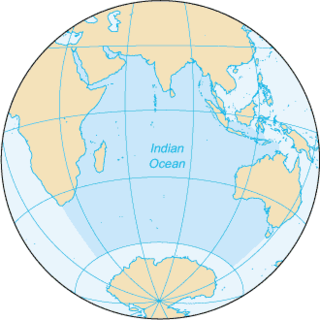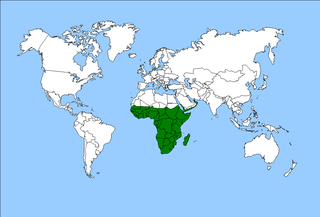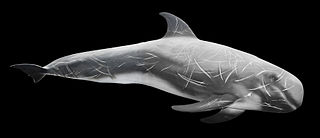
The Atlantic Ocean is the second-largest of the world's five oceans, with an area of about 85,133,000 km2 (32,870,000 sq mi). It covers approximately 17% of Earth's surface and about 24% of its water surface area. During the Age of Discovery, It was known for separating the "Old World" from the "New World".

The Indian Ocean is the third-largest of the world's five oceanic divisions, covering 70,560,000 km2 (27,240,000 sq mi) or ~20% of the water on Earth's surface. It is bounded by Asia to the north, Africa to the west and Australia to the east. To the south it is bounded by the Southern Ocean, or Antarctica, depending on the definition in use. Along its core, the Indian Ocean has large marginal, or regional seas, such as the Arabian Sea, Laccadive Sea, Bay of Bengal and Andaman Sea.

The Afrotropical realm is one of the Earth's eight biogeographic realms. It includes Sub-Saharan Africa, the southern Arabian Peninsula, the island of Madagascar, and the islands of the western Indian Ocean. It was formerly known as the Ethiopian Zone or Ethiopian Region.

Risso's dolphin is a dolphin, the only species of the genus Grampus. Some of the closest related species to these dolphins include: pilot whales, pygmy killer whales, melon-headed whales, and false killer whales.

An ocean current is a continuous, directed movement of seawater generated by a number of forces acting upon the water, including wind, the Coriolis effect, breaking waves, cabbeling, and temperature and salinity differences. Depth contours, shoreline configurations, and interactions with other currents influence a current's direction and strength. Ocean currents are primarily horizontal water movements.

An oceanic climate, also known as a marine climate, is the temperate climate sub-type in Köppen classification represented as Cfb, typical of west coasts in higher middle latitudes of continents, generally featuring cool summers and mild winters, with a relatively narrow annual temperature range and few extremes of temperature. Oceanic climates can be found in both hemispheres generally between 40 and 60 degrees latitude, with subpolar versions extending to 70 degrees latitude in some coastal areas. Other varieties of climates usually classified together with these include subtropical highland climates, represented as Cwb or Cfb, and subpolar oceanic or cold subtropical highland climates, represented as Cfc or Cwc. Subtropical highland climates occur in some mountainous parts of the subtropics or tropics, some of which have monsoon influence, while their cold variants and subpolar oceanic climates occur near polar or tundra regions.

Spartina is a genus of plants in the grass family, frequently found in coastal salt marshes. Species in this genus are commonly known as cordgrass or cord-grass, and are native to the coasts of the Atlantic Ocean in western and southern Europe, north-western and southern Africa, the Americas and the islands of the southern Atlantic Ocean; one or two species also occur on the western coast of North America and in freshwater habitats inland in the Americas. The highest species diversity is on the east coasts of North and South America, particularly Florida. They form large, often dense colonies, particularly on coastal salt marshes, and grow quickly. The species vary in size from 0.3–2 m tall. Many of the species will produce hybrids if they come into contact.

The blacktip shark is a species of requiem shark, and part of the family Carcharhinidae. It is common to coastal tropical and subtropical waters around the world, including brackish habitats. Genetic analyses have revealed substantial variation within this species, with populations from the western Atlantic Ocean isolated and distinct from those in the rest of its range. The blacktip shark has a stout, fusiform body with a pointed snout, long gill slits, and no ridge between the dorsal fins. Most individuals have black tips or edges on the pectoral, dorsal, pelvic, and caudal fins. It usually attains a length of 1.5 m (4.9 ft).

The spinner shark is a type of requiem shark, in the family Carcharhinidae, named for the spinning leaps it makes as a part of its feeding strategy. This species occurs in tropical and warm temperate waters worldwide, except for in the eastern Pacific Ocean. It is found from coastal to offshore habitats to a depth of 100 m (330 ft), though it prefers shallow water. The spinner shark resembles a larger version of the blacktip shark, with a slender body, long snout, and black-marked fins. This species can be distinguished from the blacktip shark by the first dorsal fin, which has a different shape and is placed further back, and by the black tip on the anal fin. It attains a maximum length of 3 m (9.8 ft).

Perna perna, the brown mussel, is an economically important mussel, a bivalve mollusc belonging to the family Mytilidae. It is harvested as a food source but is also known to harbor toxins and cause damage to marine structures. It is native to the waters of Africa, Europe, and South America and was introduced in the waters of North America.

The following outline is provided as an overview of and introduction to Oceanography.

The borders of the oceans are the limits of Earth's oceanic waters. The definition and number of oceans can vary depending on the adopted criteria. The principal divisions of the five oceans are the Pacific Ocean, Atlantic Ocean, Indian Ocean, Southern (Antarctic) Ocean, and Arctic Ocean. Smaller regions of the oceans are called seas, gulfs, bays, straits, and other terms. Geologically, an ocean is an area of oceanic crust covered by water.

Scorpaena scrofa, the red scorpionfish, bigscale scorpionfish, large-scaled scorpion fish, or rascasse is a venomous marine species of ray-finned fish in the family Scorpaenidae, the scorpionfishes. It is found in the Mediterranean Sea, in the eastern Atlantic Ocean and the western Indian Ocean.

Chaetodon zanzibarensis, the Zanzibar butterflyfish, is a species of marine ray-finned fish, a butterflyfish belonging to the family Chaetodontidae. It has a wide distribution throughout the western Indian Ocean stretching from the eastern coast of Africa to Madagascar, the Seychelles, Réunion and Mauritius. Its named after the Tanzanian island of Zanzibar
Chlidonophoridae is a family of brachiopods belonging to the order Terebratulida.
Deslongchampsithyris is a genus of brachiopods in the family Chlidonophoridae.
Chlidonophora chuni(Blochmann, 1903) is a extant species of brachiopods in the family Chlidonophoridae.
Chlidonophora incerta is a species of brachiopod in the family Chlidonophoridae.













